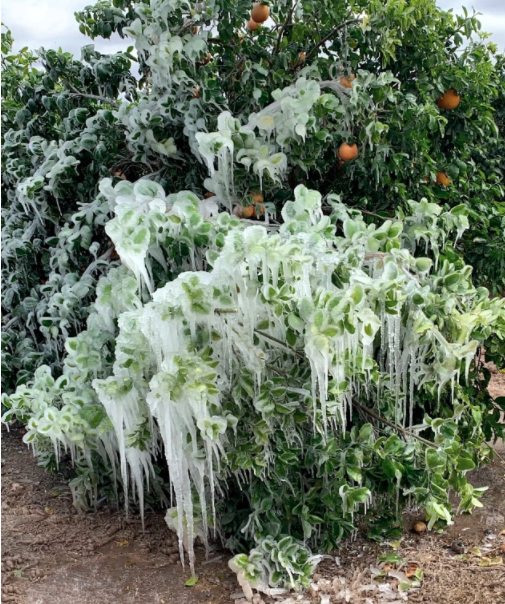Winter storm in the US might cause USD 300 million loss in citrus
Last week, on February 15th, an unexpected winter storm hit Texas, causinglife losses, power outages, and critical damages on agricultural products, especially the citrus groves in the region. Texas is the third largest citrus-producing and exporting region in the US and the second in case of grapefruits, and the main producing regions are concentrated in Rio Grande Valley, Cameron, Hidalgo, and Willacy counties. Last week's cold arctic conditions have brought temperatures below 20 degrees Fahrenheit (-6.7 degrees Celsius) in some areas for several hours. Citrus growers say that the fruits that are still on the branches start to freeze from the inside if they are exposed to temperatures below 28 degrees Fahrenheit (-2.2 degrees Celsius)for more than five hours. This climate condition can damage the fruit permanently since they will become mushy when temperatures get higher, and the fruit unfreezes. Actually, the loss of trees is a more crucial issue compared to the loss of fruits, and this will be evaluated in the coming weeks.

Source: Dale Murden, president of Texas Citrus Mutual
Citrus growers of Texas ship their products domestically and internationally, especially to Canada and Europe. They expected to ship out 12 million boxes by the end of the season in May. But close to half of the grapefruit crop (86 thousand MT) and all of the late oranges (21 thousand MT) were lost during the winter storm. The loss is estimated to reach USD 78 million, and if the trees are not viable to produce by next season, the losses could be as high as USD 225 million, totaling a loss of over USD 300 million. The Grower's Association in the Valley, Texas Citrus Mutual, are concerned that many growers might cut down their citrus trees and move on to a different crop after these unprecedented losses.
USDA forecast of citrus before the storm
The latest USDA citrus forecast was released just days before the storm hit Texas on February 9th. It had already estimated a total retreat by 8.68% in the citrus production for the MY 2020/21 in the US. But the reductions were in California and Florida respectively, forecasted to produce, 153.2 million boxes (-3.10%) and 117.7 million boxes (-16.25%). Despite that Texas showed a recovery compared to the previous MY with 8 million boxes (+13%), it is still below the growers' forecasted volume. Still, the next forecast to be released on March 9th will also likely be reduced to include recent developments.

Source: Tridge, USDA
Texas's citrus growers have been going through a series of challenges since last year starting with the COVID-19 hitting the US and disrupting logistics. Last July, the citrus industry suffered severe crop losses of USD 100 million, caused by Hurricane Hanna that hit the State hard. All followed by the Winter storm last week.
Other damages
The effects of the freezing weather did not only affect the citrus industry, but also the agricultural industry overall. Production of winter season crops like leafy greens, onions, and beets was also affected directly. Some of the warmer season crops like potatoes, watermelon, and early corn and sorghum crops can also be affected. The buds of peach trees and strawberries will also be frozen and become a loss that will take some weeks to recover, delaying the next harvest.
The damages also extend to livestock and poultry. The power outages unabled hatcheries to warm up the hatching eggs and turn on the newborns' heaters, making them prone to freezing to death. Livestock was also suffering from thirst and hunger as their drinking water was frozen, as there is no way to melt it without fuel or energy, and farms went out of feed. The milk industry was pouring down about USD 8 million worth of milk daily as they cannot run their machinery to pasteurize the milk or even bottle it. This week, the temperatures have hit the 70s degrees Fahrenheit (21 degrees Celsius) but the consumers will feel all the damage in agriculture as it will take a few weeks to stock all the supermarkets again fully, and the price will be inflated as a reflection of the weather disaster.
Temperatures in Texas on February 23rd

Source: Accuweather
Sources
- Accuweather. "Cold snap deep in Texas almost certainly means crop losses for citrus growers".
- Agrilife. "Arctic conditions deliver frigid blow to Texas agriculture".
- FreshPlaza. "Texas loses at least 300 million in citrus due to storm".
- Khou. "Winter storm wreaks havoc on Rio Grande Valley crops, impacts farmers, consumers"
- National Public Radio. "Texas Winter Storm Wreaks Havoc On Farmers"
- Reuters. "Texas loses at least $300 million in citrus crops to storm"
- USDA. Forecast of citrus-February.
- Yahoo. "Cold snap deep in Texas almost certainly means crop losses for citrus growers"

